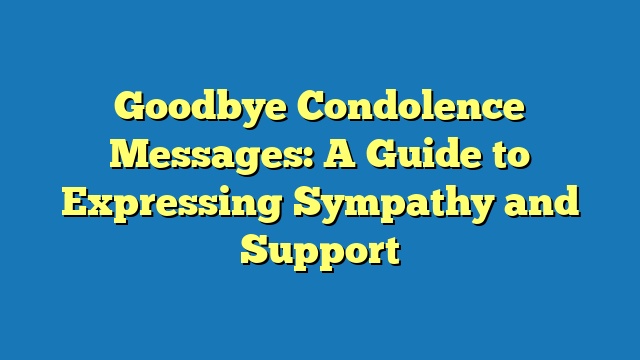Goodbye condolence messages are a special type of farewell note sent to express sympathy and condolences to those who have lost a loved one. They are designed to provide comfort and support during a difficult time. For example, a message might read: “I am so sorry for your loss. My thoughts and prayers are with you during this difficult time.”
Goodbye condolence messages have been used for centuries to express sympathy and support. They are an important way to show that you care about someone who is grieving. The messages can also be beneficial for those who are grieving, as they can provide comfort and support during a difficult time.
One of the key historical developments in goodbye condolence messages was the use of the internet. In the past, messages were typically sent by mail or in person. However, the internet now allows messages to be sent quickly and easily to anyone in the world. This has made it possible for people to stay connected with each other during difficult times.
Goodbye Condolence Messages
Goodbye condolence messages are an important way to express sympathy and support to those who have lost a loved one. They can provide comfort and support during a difficult time. Some essential aspects of goodbye condolence messages include:
- Sincerity
- Empathy
- Brevity
- Personalization
- Appropriateness
- Timeliness
- Respect
- Support
- Hope
- Closure
When writing a goodbye condolence message, it is important to keep these aspects in mind. A sincere and empathetic message will be more meaningful to the recipient than a generic or impersonal one. It is also important to be brief and to the point, as the recipient may not be in the mood to read a long message. Personalizing the message with a specific memory or anecdote can also make it more meaningful. Finally, it is important to be respectful of the recipient’s grief and to offer support and hope for the future.
Sincerity
Sincerity is one of the most important aspects of goodbye condolence messages. When a message is sincere, it comes from the heart and is not simply a formality. Sincere messages are more likely to be meaningful to the recipient and to provide comfort and support during a difficult time.
There are many ways to express sincerity in a goodbye condolence message. One way is to use personal anecdotes or memories. For example, you might share a story about how you knew the deceased person or how they impacted your life. Another way to express sincerity is to be specific about what you are offering. For example, you might say, “I am here for you if you need anything” or “I will always cherish the memories I have of your loved one.”
Sincerity is critical to goodbye condolence messages because it helps to create a connection between the sender and the recipient. When a message is sincere, it shows that the sender cares about the recipient and is there to support them. This can be a great comfort to those who are grieving, as it can help them to feel less alone.
Empathy
Empathy refers to the ability to understand and share the feelings of another person. In the context of goodbye condolence messages, empathy is essential for crafting meaningful and supportive messages that resonate with those who are grieving.
-
Understanding Perspective
Empathy begins with understanding the perspective of the person who is grieving. This involves putting oneself in their shoes and trying to see the world from their point of view. Only then can one truly understand the depth of their loss and the emotions they are experiencing.
-
Recognizing Emotions
Empathy also involves recognizing and acknowledging the emotions that the person is experiencing. This could include sadness, anger, guilt, or even numbness. It is important to avoid dismissive language or platitudes that minimize their feelings.
-
Offering Support
Empathy extends beyond understanding and recognizing emotions to offering support and comfort to the person who is grieving. This could involve listening to them, offering practical help, or simply being present for them.
-
Respecting Boundaries
Finally, empathy involves respecting the boundaries of the person who is grieving. This means giving them the space they need and allowing them to grieve in their own way. It also means avoiding overwhelming them with unsolicited advice or trying to fix their problems.
By incorporating these facets of empathy into goodbye condolence messages, one can create messages that are truly meaningful and supportive. These messages can help to provide comfort and solace to those who are grieving and let them know that they are not alone.
Brevity
Brevity is a crucial component of goodbye condolence messages. When someone is grieving, they may not have the time or energy to read a long, rambling message. A brief message that is to the point will be more likely to be read and appreciated.
There are several ways to be brief in a goodbye condolence message. One way is to avoid using unnecessary words or phrases. Another way is to use simple and direct language. Finally, it is important to focus on the most important points that you want to convey.
Here is an example of a brief goodbye condolence message:
I am so sorry for your loss. My thoughts are with you during this difficult time.
This message is brief and to the point, but it still conveys the sender’s sympathy and support. As a result, it is likely to be well-received by the recipient.
Brevity is an important aspect of goodbye condolence messages because it allows the sender to convey their sympathy and support in a way that is respectful of the recipient’s time and energy. When writing a goodbye condolence message, it is important to keep brevity in mind.
Personalization
In the realm of goodbye condolence messages, personalization plays a pivotal role in conveying empathy and offering meaningful support during a time of grief. It involves tailoring the message to the specific individual and their unique relationship with the deceased loved one, thereby creating a more profound and comforting expression of sympathy.
-
Incorporating Memories:
Sharing cherished memories of the deceased person can evoke a sense of connection and provide solace to the grieving individual. By recalling special moments, anecdotes, or qualities of the departed, the message becomes a personalized tribute that celebrates their life and legacy.
-
Acknowledging the Relationship:
Recognizing the nature of the relationship between the deceased and the recipient demonstrates that the sender understands the depth of their loss. Whether they were a close family member, a dear friend, or a respected colleague, acknowledging this bond adds a layer of authenticity and empathy to the message.
-
Using Specific Details:
Including specific details about the deceased person, such as their hobbies, interests, or accomplishments, shows that the sender has taken the time to learn about their life and values. These details can make the message feel more personal and meaningful, as they resonate with the unique qualities of the individual being remembered.
-
Offering Tailored Support:
Personalizing the message can also extend to offering support that is tailored to the recipient’s specific needs. This could involve providing practical assistance, such as help with errands or household chores, or simply offering a listening ear and emotional support. Understanding the individual’s situation and offering relevant assistance demonstrates a deep level of care and consideration.
By incorporating these facets of personalization, goodbye condolence messages can transcend mere expressions of sympathy and become heartfelt gestures of support that provide comfort, solace, and a sense of connection during a time of immense grief.
Appropriateness
Appropriateness is a critical component of goodbye condolence messages. When someone is grieving, they are particularly sensitive to the words and actions of others. A message that is not appropriate can cause additional pain and distress.
There are several factors to consider when determining the appropriateness of a goodbye condolence message. These factors include the relationship between the sender and the recipient, the tone of the message, and the timing of the message.
In general, it is best to err on the side of caution when sending a goodbye condolence message. It is better to send a message that is too formal than one that is too informal. It is also better to send a message that is too brief than one that is too long.
Here are some examples of appropriate goodbye condolence messages:
- “I am so sorry for your loss. My thoughts and prayers are with you during this difficult time.”
- “I was so saddened to hear about the passing of your loved one. I will always cherish the memories I have of them.”
- “I know that words cannot express your pain, but I want you to know that I am here for you if you need anything.”
By following these guidelines, you can ensure that your goodbye condolence message is appropriate and respectful.
Timeliness
Timeliness is a crucial aspect of goodbye condolence messages. Sending a message at the right time can provide comfort and support to those who are grieving. Conversely, sending a message that is too late or too early can cause additional pain and distress.
-
Promptness
Sending a goodbye condolence message promptly shows that you are thinking of the person who is grieving and that you care about their well-being. It is generally best to send a message within a few days of hearing about the death.
-
Respect for the Grieving Process
It is important to respect the grieving process and to give the person time to mourn. In some cases, it may be best to wait a few weeks or even months before sending a message. This will give the person time to process their emotions and to begin to heal.
-
Special Occasions
There are certain special occasions, such as the anniversary of the death or the holidays, when it may be especially meaningful to send a goodbye condolence message. These messages can serve as a reminder that the person who is grieving is not alone and that you are still thinking of them.
-
Ongoing Support
Grief is a journey, and it can take time to heal. It is important to offer ongoing support to those who are grieving. This could involve sending a message every few months or even years to let the person know that you are still thinking of them.
By being mindful of timeliness, you can ensure that your goodbye condolence message is well-received and provides comfort and support to those who are grieving.
Respect
Respect is a crucial component of goodbye condolence messages. When someone is grieving, they are particularly sensitive to the words and actions of others. A message that is not respectful can cause additional pain and distress.
There are several ways to show respect in a goodbye condolence message. One way is to use respectful language. This means avoiding using slang, jargon, or offensive language. Another way to show respect is to be mindful of the recipient’s culture and beliefs. For example, if you know that the recipient is religious, you may want to include a religious quote or prayer in your message.
It is also important to be respectful of the recipient’s privacy. This means not sharing personal information about the deceased person without the recipient’s permission. Additionally, it is important to be respectful of the recipient’s need for space. If the recipient does not want to talk about the deceased person, it is important to respect their wishes.
By following these guidelines, you can ensure that your goodbye condolence message is respectful and supportive.
Support
Support is a crucial aspect of goodbye condolence messages. When someone is grieving, they need to know that they are not alone. A message of support can provide comfort and strength during a difficult time.
-
Emotional Support
Emotional support involves offering empathy, compassion, and understanding. It means listening to the person who is grieving without judgment and providing a shoulder to cry on. Emotional support can also involve sharing memories of the deceased person and talking about the positive impact they had on the world.
-
Practical Support
Practical support involves providing tangible assistance to the person who is grieving. This could include helping with errands, cooking meals, or providing transportation. Practical support can also involve offering to take care of the deceased person’s pets or plants.
-
Companionship
Companionship involves spending time with the person who is grieving. This does not mean that you need to constantly talk about the deceased person. It simply means being there for the person and providing a listening ear. Companionship can also involve doing activities together, such as going for a walk or watching a movie.
-
Financial Support
Financial support may be necessary in some cases, especially if the deceased person was the primary breadwinner. Financial support can involve helping with funeral expenses, paying for groceries, or providing a loan. Financial support can also involve setting up a crowdfunding page or donating to a charity in the deceased person’s name.
By providing support, you can help the person who is grieving to cope with their loss and to begin the healing process.
Hope
In the tapestry of goodbye condolence messages, hope emerges as a luminous thread, offering solace and strength to those navigating the depths of grief. Hope is not a fleeting wish but a profound force that sustains and guides during times of darkness.
-
Beacon of Light
Hope serves as a beacon of light, illuminating a path through the dense fog of grief. It reminds us that even in the face of profound loss, the embers of joy and meaning still flicker within us.
-
Source of Comfort
Hope offers a soothing balm, easing the raw wounds of loss. It whispers that time, though it cannot erase the pain, can soften its edges and bring moments of respite.
-
Anchor in Faith
For many, hope finds its anchor in faith. The belief in a higher power or a spiritual connection provides a sense of purpose and solace, reminding us that even in death, love endures.
-
Promise of Renewal
Hope carries the promise of renewal, reminding us that life continues in myriad forms. The legacy of the departed may inspire us to live more fully, to cherish our relationships, and to find meaning in the face of adversity.
In the symphony of goodbye condolence messages, hope plays a vital role. It offers a lifeline to those who are drowning in sorrow, providing strength, comfort, and the promise of a brighter tomorrow. Like a gentle breeze, it whispers a message of resilience, reminding us that even in the depths of despair, hope endures.
Closure
In the realm of grief and loss, closure emerges as a profound concept intricately intertwined with goodbye condolence messages. Closure refers to the psychological and emotional process of coming to terms with a loss and finding a sense of peace and acceptance. Goodbye condolence messages, in turn, play a pivotal role in facilitating this process, offering solace, support, and a space for reflection.
The absence of closure can prolong the grieving process, hindering the ability to move forward and heal. Goodbye condolence messages, by acknowledging the loss and expressing sympathy, help to validate the emotions of the bereaved and initiate the journey towards closure. They provide an opportunity for individuals to share memories, express their feelings, and begin to process the complex emotions associated with loss.
Real-life examples abound where goodbye condolence messages have served as catalysts for closure. A heartfelt message from a cherished friend, recalling fond memories of the deceased, can offer immense comfort and help to ease the pain of loss. A letter from a colleague, expressing appreciation for the deceased’s contributions and offering support during this difficult time, can provide a sense of validation and help to mitigate feelings of isolation.
Understanding the connection between closure and goodbye condolence messages has practical applications in various settings. Counselors and therapists can incorporate the use of goodbye condolence messages into their practice, encouraging their clients to engage in this form of expressive writing as a means of promoting healing. Support groups for bereaved individuals can facilitate the sharing of goodbye condolence messages, creating a safe and supportive environment for individuals to process their emotions and find solace in the collective experience of loss.
In conclusion, goodbye condolence messages are not merely expressions of sympathy but potent tools that can facilitate closure, promote healing, and support individuals as they navigate the arduous journey of grief. By acknowledging the profound impact of goodbye condolence messages on the grieving process, we can harness their power to provide solace, initiate healing, and help individuals find peace and acceptance amidst loss.
FAQs about Goodbye Condolence Messages
This section addresses frequently asked questions and clarifies aspects related to goodbye condolence messages.
Question 1: What is the purpose of goodbye condolence messages?
Answer: Goodbye condolence messages express sympathy, support, and comfort to those who have lost a loved one. They aim to acknowledge the loss and provide emotional support during a difficult time.
Question 2: What should I include in a goodbye condolence message?
Answer: Consider including sincere expressions of sympathy, personal memories or anecdotes, and words of support and comfort. Be brief, respectful, and tailored to the recipient’s beliefs and relationship with the deceased.
Question 3: How do I express empathy in a goodbye condolence message?
Answer: Acknowledge the recipient’s emotions and show understanding of their pain. Avoid dismissive language or platitudes, and focus on validating their feelings and offering support.
Question 4: Can I send a goodbye condolence message even if I did not know the deceased person?
Answer: Yes, you can send a message to express sympathy and support to the bereaved individual, even if you did not have a direct connection with the deceased.
Question 5: How long should a goodbye condolence message be?
Answer: Keep the message brief and to the point, while still conveying your sincerity and support. A few heartfelt sentences or a short paragraph is generally sufficient.
Question 6: Is it appropriate to send a goodbye condolence message on social media?
Answer: While social media platforms can be used to express condolences, it is important to be mindful of the recipient’s privacy and preferences. Consider sending a private message or reaching out through other channels if you are unsure.
In summary, goodbye condolence messages play a vital role in providing empathy, support, and comfort during times of grief. By understanding their purpose and following these guidelines, we can create meaningful messages that offer solace and support to those who need it most.
In the next section, we will explore the importance of personalization in goodbye condolence messages and provide tips on how to create messages that are tailored to the specific recipient and their relationship with the deceased.
Tips for Writing Goodbye Condolence Messages
In this section, we will provide specific and actionable tips to help you create meaningful and supportive goodbye condolence messages.
Tip 1: Personalize the Message
Take the time to tailor your message to the recipient and their relationship with the deceased. Include specific memories or anecdotes that demonstrate your understanding of their unique bond.
Tip 2: Express Empathy
Acknowledge the recipient’s pain and emotions without using dismissive language or platitudes. Let them know that you understand their grief and are there for them.
Tip 3: Offer Specific Support
Go beyond general expressions of sympathy by offering specific support. For instance, you could mention that you are available to run errands, provide meals, or simply listen whenever they need.
Tip 4: Use Respectful Language
Choose your words carefully and avoid using slang, offensive language, or religious references that may not be appropriate for the recipient’s beliefs.
Tip 5: Be Brief and Sincere
Keep your message concise and to the point, while still conveying your heartfelt sympathy. A few sincere sentences are often more meaningful than a long, rambling message.
Tip 6: Consider Cultural Differences
Be aware of the cultural background and beliefs of the recipient. Certain phrases or customs may have different meanings in different cultures, so it is important to be respectful and sensitive.
Tip 7: Proofread Carefully
Before sending your message, take a moment to proofread it carefully for any errors in grammar or spelling. A well-written message shows that you have taken the time to express your condolences in a thoughtful and respectful manner.
Tip 8: Send Your Message Promptly
It is generally best to send your goodbye condolence message within a few days of hearing about the loss. This shows that you are thinking of the person during their time of grief.
By following these tips, you can create goodbye condolence messages that are personal, supportive, and respectful. These messages can provide comfort and solace to those who are grieving and help them to navigate the difficult journey of loss.
In the final section of this article, we will discuss the importance of sensitivity and respect when writing goodbye condolence messages. We will provide additional tips on how to avoid causing further pain or distress to the recipient.
Conclusion
Goodbye condolence messages serve as essential expressions of sympathy and support during times of grief. They play a vital role in acknowledging the loss, providing emotional comfort, and facilitating the grieving process. Through personalization, empathy, and respectful language, these messages can offer solace and support to those who are navigating the difficult journey of loss.
Two main points emerge from our exploration of goodbye condolence messages: Firstly, personalization is crucial for creating meaningful messages that resonate with the recipient’s unique relationship with the deceased. Secondly, empathy and sensitivity are essential to avoid causing further pain or distress to those who are grieving. By understanding these principles and following the tips outlined in this article, we can craft goodbye condolence messages that provide genuine comfort and support during times of need.








